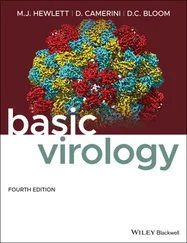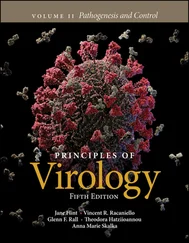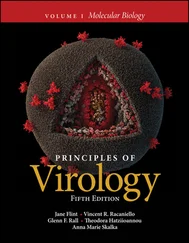Jane Flint - Principles of Virology
Здесь есть возможность читать онлайн «Jane Flint - Principles of Virology» — ознакомительный отрывок электронной книги совершенно бесплатно, а после прочтения отрывка купить полную версию. В некоторых случаях можно слушать аудио, скачать через торрент в формате fb2 и присутствует краткое содержание. Жанр: unrecognised, на английском языке. Описание произведения, (предисловие) а так же отзывы посетителей доступны на портале библиотеки ЛибКат.
- Название:Principles of Virology
- Автор:
- Жанр:
- Год:неизвестен
- ISBN:нет данных
- Рейтинг книги:3 / 5. Голосов: 1
-
Избранное:Добавить в избранное
- Отзывы:
-
Ваша оценка:
- 60
- 1
- 2
- 3
- 4
- 5
Principles of Virology: краткое содержание, описание и аннотация
Предлагаем к чтению аннотацию, описание, краткое содержание или предисловие (зависит от того, что написал сам автор книги «Principles of Virology»). Если вы не нашли необходимую информацию о книге — напишите в комментариях, мы постараемся отыскать её.
Volume I: Molecular Biology
Volume II: Pathogenesis and Control
Principles of Virology, Fifth Edition
Principles of Virology — читать онлайн ознакомительный отрывок
Ниже представлен текст книги, разбитый по страницам. Система сохранения места последней прочитанной страницы, позволяет с удобством читать онлайн бесплатно книгу «Principles of Virology», без необходимости каждый раз заново искать на чём Вы остановились. Поставьте закладку, и сможете в любой момент перейти на страницу, на которой закончили чтение.
Интервал:
Закладка:
Some virus particles comprise only the nucleic acid genome and structural proteins necessary for protection and delivery into a host cell. However, many contain additional viral proteins, which are generally present at much lower concentrations but essential or important for establishing an efficient infectious cycle ( Table 4.3).
Enzymes
Many types of virus particles contain enzymes necessary for synthesis of viral nucleic acids. These enzymes generally catalyze reactions unique to virus-infected cells, such as synthesis of viral mRNAs from an RNA template or of viral DNA from an RNA template (retroviral reverse transcriptases). However, virions of vaccinia virus contain a DNA-dependent RNA polymerase, analogous to cellular RNA polymerases, as well as several enzymes that modify viral RNA transcripts ( Table 4.3). This complement of enzymes is necessary because transcription of the viral double-stranded DNA genome takes place in the cytoplasm of infected cells, whereas cellular DNA-dependent RNA polymerases and the RNA-processing machinery are restricted to the nucleus. Other types of enzymes found in virus particles include integrase, cap-dependent endonuclease, and proteases. The proteases sever covalent connections within polyproteins or precursor proteins from which some virus particles assemble, a reaction that is necessary for the production of infectious particles ( Chapter 13).
Other Viral Proteins
Virus particles may also contain additional viral proteins that are not enzymes but nonetheless are important for an efficient infectious cycle. Among the best characterized are the protein primers for viral genome replication that are covalently linked to the genomes of picornaviruses such as poliovirus and adenoviruses. Others include several tegument proteins of herpesviruses, such as the VP16 protein, which activates transcription of viral immediate-early genes to initiate the viral program of gene expression. The cores of vaccinia virus also contain proteins that are essential for transcription of viral genes, as they allow recognition of viral early promoters. Other herpesvirus tegument proteins induce the degradation of cellular mRNA or block cellular mechanisms by which viral proteins are presented to the host’s immune system. Retroviruses with complex genomes, such as human immunodeficiency virus type 1, contain additional proteins required for efficient viral reproduction in certain cell types. These proteins are discussed in Volume II, Chapter 12.
Table 4.3 Some virion enzymes
| Virus | Protein | Function(s) |
|---|---|---|
| Adenovirus | ||
| Human adenovirus type 2 | L3 23k | Protease; production of infectious particles |
| Herpesvirus | ||
| Herpes simplex virus type 1 | VP24 | Protease; capsid maturation for genome encapsidation |
| UL13 | Protein kinase | |
| Vhs | RNase | |
| Orthomyxovirus | ||
| Influenza A virus | P proteins | RNA-dependent RNA polymerase; synthesis of viral mRNA and vRNA; cap-dependent endonuclease |
| Poxvirus | ||
| Vaccinia virus a | DNA-dependent RNA polymerase (8 subunits) | Synthesis of viral mRNA |
| Poly(A) polymerase (2 subunits) | Synthesis of poly(A) on viral mRNA | |
| Capping enzyme (2 subunits) | Addition of 5' caps to viral pre-mRNA | |
| DNA topoisomer ase | Sequence-specific nicking of viral DNA | |
| Proteases 1 and 2 | Virus particle morphogenesis | |
| Reovirus | ||
| Reovirus type 1 | λ2 | Guanylyltransferase |
| λ3 | Double-stranded RNA-dependent RNA polymerase | |
| Retrovirus | ||
| Human immunodeficiency virus | Pol | Reverse transcriptase; proviral DNA synthesis |
| type 1 | ||
| IN | Integrase; integration of proviral DNA into the cellular genome | |
| PR | Protease; production of infectious particles | |
| Rhabdovirus | ||
| Vesicular stomatitis virus | L | RNA-dependent RNA polymerase; synthesis of viral mRNA and vRNA |
a Vaccinia virions contain some 20 enzymes, only a few of which are listed.
Cellular Macromolecules
Virus particles can also contain cellular macromolecules that play important roles during the infectious cycle, such as the cellular histones that condense and organize polyomaviral and papillomaviral DNAs. Because they are formed by budding, enveloped viruses can readily incorporate cellular proteins and other macromolecules. For example, cellular glycoproteins may not be excluded from the membrane from which the viral envelope is derived. Furthermore, as a bud enlarges and pinches off during virus assembly, internal cellular components may be trapped within it. Enveloped viruses are also generally more difficult to purify than naked viruses. Indeed, analysis by the sensitive proteomic methods provided by mass spectrometry has identified from 50 to 100 cellular proteins in purified, enveloped particles of various herpesviruses, filoviruses, and rhabdoviruses. Consequently, it can be difficult to distinguish cellular components specifically incorporated into enveloped virus particles from those trapped randomly or copurifying with the virus. Nevertheless, in some cases it is clear that cellular molecules are important components of virus particles: these molecules are reproducibly observed at a specific stoichiometry and can be shown to be essential or play pivotal roles in the infectious cycle. The cellular components captured in retrovirus particles have been particularly well characterized.
The primer for initiation of synthesis of the (−) strand DNA during reverse transcription in retroviral genomes is a specific cellular transfer RNA (tRNA), such as tRNALys3 in the case of human immunodeficiency virus type 1. These RNAs are incorporated into virus particles via association with the reverse transcriptase domains of one type of polyprotein (Gag-Pol) that in turn is assembled into particles via interactions with the Gag polyprotein ( Chapter 13). The cognate human lysyl tRNA synthase is also selectively packaged into human immunodeficiency virus type 1 particles and facilitates initiation of reverse transcription ( Chapter 10).
A variety of membrane proteins have been observed in retrovirus particles, but appear to be acquired nonspecifically by virtue of their presence at the sites of particle budding. In contrast, several cytoplasmic proteins of the host cell are packaged specifically. It was reported more than 20 years ago that human immunodeficiency virus type 1 particles contain cellular cyclophilin A (PPIase A). This chaperoneis the major cytoplasmic member of a ubiquitous family of peptidyl-prolyl isomerases. It is bound to the N terminus of the capsid (CA) protein and catalyzes isomerization of a single Gly-Pro bond in the protein. Substitutions in CA that impair binding of cyclophilin A reduce the infectivity of virus particles in some cell types. However, the effects of depletion of the cellular chaperone and of its inhibitors in virus-producing cells or in newly infected target cells have established that it is PPIase A present in new target cells, not the protein carried by incoming virus particles, that is important. Its presence in virus particles is simply a secondary consequence of interactions with the CA domain of viral polyproteins.
Читать дальшеИнтервал:
Закладка:
Похожие книги на «Principles of Virology»
Представляем Вашему вниманию похожие книги на «Principles of Virology» списком для выбора. Мы отобрали схожую по названию и смыслу литературу в надежде предоставить читателям больше вариантов отыскать новые, интересные, ещё непрочитанные произведения.
Обсуждение, отзывы о книге «Principles of Virology» и просто собственные мнения читателей. Оставьте ваши комментарии, напишите, что Вы думаете о произведении, его смысле или главных героях. Укажите что конкретно понравилось, а что нет, и почему Вы так считаете.











